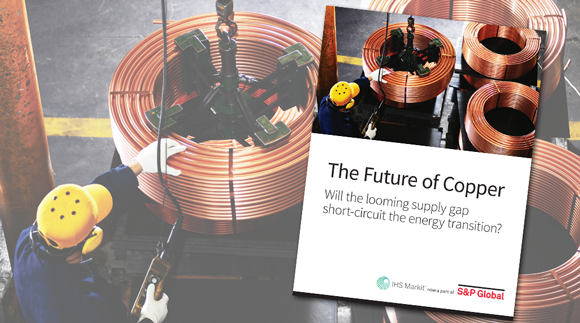S&P study finds copper supply may pose challenge in achieving net-zero goals
July 25, 2022

Analytics company S&P Global, headquartered in New York, USA, has published a study entitled ‘The Future of Copper: Will the looming supply gap short-circuit the energy transition’. This study comes as a response to concerns raised by authorities – including the US government, the International Monetary Fund and the International Energy Agency – about the availability and reliability of minerals needed to reach climate goals.
The study projects that copper demand will nearly double in the next decade – from 25 to 50 million metric tons – in order to deploy the technologies necessary to achieve net-zero goals by 2050. This demand is expected to grow to 53 million metric tons in 2050: more than all of the copper consumed in the world between 1900 and 2021.
The study utilises a detailed bottom-up approach, technology by technology, to quantify the amount of additional copper that will be required by increased electrification and the energy transition – most specifically, the rapid move to electric vehicles and renewable electricity and the need for increased electricity infrastructure. It then examines the ability of copper supply to meet that demand on the basis of current trends, or with an unprecedented acceleration of supply from mining and recycling. It also identifies the key operational risks that can constrain future supplies.
“Copper is the metal of electrification and absolutely essential to the energy transition,” stated Daniel Yergin, vice chairman, S&P Global. “Given the global consensus for Net-Zero Emissions by 2050, it is critical to understand the physical materials required for achieving that ambition. The world has never produced so much copper in such a short timeframe as would be required. On current trends, the doubling of global copper demand by 2035 would result in significant shortfalls.”
Notably, the study posits, growth in new copper supply capacity – from new mines or expansions of existing projects – would unlikely be able to keep pace with the surge in demand. The International Energy Agency has estimated that it currently takes sixteen years, on average, to develop a new mine, meaning that a new mine seeking permission today would not become productive in time to accommodate the demand spike.
That leaves increases in capacity utilisation (output as a percentage of an existing mine’s total capacity) and recycling as the main sources of additional supply, according to the study.
Under current trends—whereby both capacity utilisation and recycling rates remain at their current ten-year global average—the study’s Rocky Road Scenario projects annual supply shortfalls that reach nearly 10 million metric tons in 2035. That is equivalent to 20% of the demand projected to be required for a 2050 net-zero world.
“This comprehensive analysis demonstrates that, even at the outer edge of what could happen in copper mining and refining operations, there would not be enough supply to meet the demands of a Net-Zero Emissions by 2050 world,” added Mohsen Bonakdarpour, executive director, economics and country risk, S&P Global Market Intelligence. “Even strong price signals and incentivising policy initiatives, aggressive capacity utilization rates and all-time high recycling rates would not be enough to close the gap.”
Such a supply gap would have broader consequences across the global economy, disrupting supply chains for both energy transition and non-energy transition industries, the study says. Given copper’s use in a wide range of end markets, it would also exert tremendous upward pressure on the cost of goods for global manufacturers as well as energy costs for consumers.
The study also finds that the burgeoning supply gap would exacerbate the growing reliance on copper imports in the United States, in particular. Imports made up nearly 44% of US copper usage in 2021 — up from just 10% in 1995. Under the study’s scenarios, that share would swell to between 57 and 67% by 2035. An intensifying competition for critical metals is very likely to have geopolitical implications, the study says.
“The challenge for all active participants in the energy transition will be to manage often competing and seemingly contradictory priorities in this New Era of Copper Demand,” said John Mothersole, director, non-ferrous metals, S&P Global Market Intelligence. “Technology and innovation will both be critical in meeting this challenge, as will partnership between governments, producers and end-users. ‘Dr. Copper’, as the metal is called, may well currently be, as it has been in the past, a leading indicator of a slowdown in economic growth or recession, but the overall supply outlook for the years ahead is extremely tight.”
The full study is available here.














